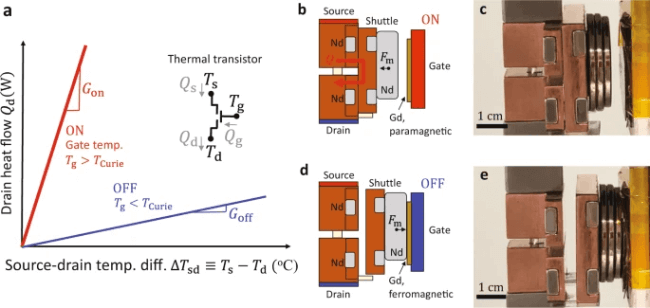Three-Terminal Magnetic Thermal Transistors: Expanding the Scope of Thermal Devices
21-02-2023 | By Liam Critchley
Analogies between thermal and electrical devices have been useful in the past for developing switchable and non-linear thermal devices―using the electrical counterpart as a guide. Using electrical device function and architecture as an inspiration for thermal devices is possible due to a number of different mechanistic analogies that can be exploited across both devices.
On the one hand, temperature differences in a thermal device are analogous to voltage differences in electrical devices, while on the other hand, heat flows are analogous to electrical currents, making it possible to create thermal devices that function similarly to electrical devices but use heat rather than electrons.
It’s a concept that has been shown in several devices, including two-terminal thermal diodes that display thermal rectification and two-terminal thermal switches. These thermal devices have found use in thermal regulation, waste heat scattering, solid-state cooling and battery thermal management. While a number of two-terminal thermal devices have been created using electrical analogues as a guide, there is interest in increasing the scope out to three-terminal thermal devices.
An Interest in Three-Terminal Thermal Transistors
Even though there’s a lot of interest in creating three-terminal thermal transistor devices, there has not yet been any experimental realisation of a three-terminal device that is thermally analogous to an electrical transistor. Three terminal devices are of great interest, with electrical field-effect transistors (FETs) being one of the key electrical devices of interest to base a three-terminal thermal transistor around.
FETs are three-terminal transconductance devices where the current flows between a source and a drain and is controlled by either the gate-drain or gate-source voltage. It could also be possible to base a thermal transistor around three-terminal electrical bipolar junction transistors (BJTs), where the collector current is controlled by the base-emitter current. Three-terminal thermal transistors could be analogous to these three-terminal electrical transistors through the control of the temperature and heat flow at one terminal controlling the heat flow between the other two terminals―as this would lead to a device where the heat flow facilitates switching and amplification functions.
While electronic transistors have revolutionised modern-day technology and are the core reason for computing advances over the last few decades, researchers are targeting different applications and markets for thermal transistors. Some areas that have been floated as a possibility include precision thermal management, advanced thermal sensing, and passive thermal computation in harsh and remote climates.
Creating a Three-Terminal Thermal Transistor
Previous research into three-terminal thermal transistors has all been computationally based and has focused around the transistors functioning via negative differential thermal resistance (NDTR). If you make the mechanisms analogous to FETs, then NDTR mechanisms involve increasing the gate temperature, which increases the heat flow from the source into the transistor at a fixed source temperature and drain temperature. These mechanisms also require thermal non-linearities to achieve a thermal transistor function.
Despite the interest and computational work done on three-terminal thermal transistors, no experimental work has yet to be done on their physical realisation. New research set out to change this, and the result is a centimetre-scale three-terminal magnetic thermal transistor that can perform switching and amplification functions.
The new device uses the gate to control the temperature of the source-drain heat flow by toggling the source-drain thermal conductance from ON to OFF. The transistor also uses gate-temperature-dependent magnetic forces, stemming from a ferromagnetic material mounted on the gate terminal, to control the position of the thermally bridging element that connects the thermal source to the thermal drain in the ON state. This approach provides an actuating motion―like a thermally conducting shuttle―that provides a thermal contact between the source and drain in the ON state and breaks the thermal contact in the OFF state.

Fig. 1: Thermal transistor concept and implementation
Thermal measurements were performed on the transistor to gain insights into its functions. The thermal measurements showed that small heat flows in the gate can be used to drive larger heat flows from the source to the drain and that this process is reversible over more than 150 cycles. In terms of the switching ratios between states, it was found that there was steady state ON/OFF switching ratios of 109 ± 44 in a high vacuum with gate switching temperatures near 25°C.
The thermal measurements also looked at the ON and OFF states in more detail. These analyses determined that the ON and OFF state conductance’s show that the transistor is an excellent thermal insulator in the OFF state (with thermal conductivity similar to polymers) and a relatively good thermal conductivity of heat in the ON state.
Using the thermal insights, the researchers created proof-of-concept systems based around several thermal circuits to show that the device can provide both active and passive heat flow routing for controlled power generation and thermal storage applications, as well as being combined together to produce a Boolean thermal logic gate. It’s thought that for more ambitious devices, such as thermal computing or thermal sensing, the transistors could be combined in series to create a thermal AND logic gate or combined in parallel to create a thermal OR logic gate.
Three-terminal thermal sensors have been an experimental challenge to create, and research can now move on after the realisation of the first device. This magnetic thermal transistor has allowed for the switching and amplification of heat flows, and further research can now be done into more complex systems and more complex thermal devices.
Reference:

